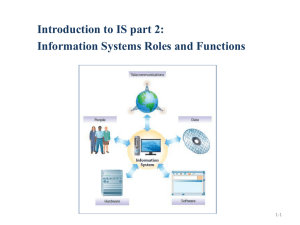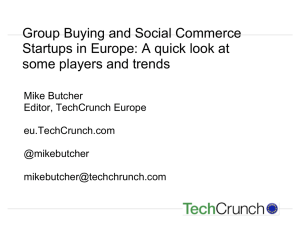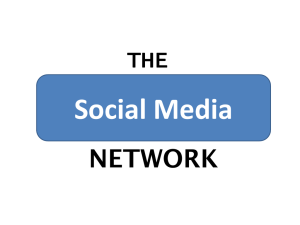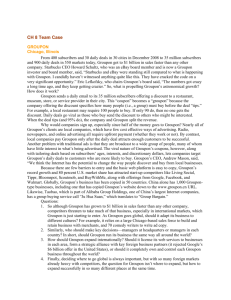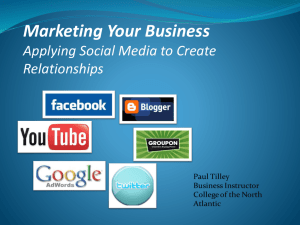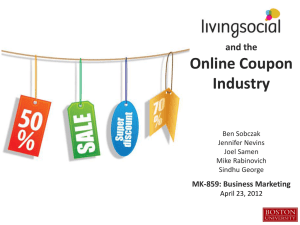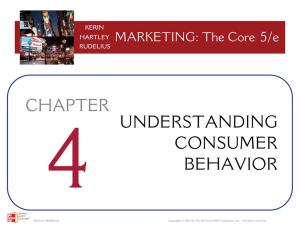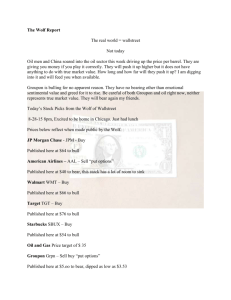Coupons of the 21st Century
advertisement
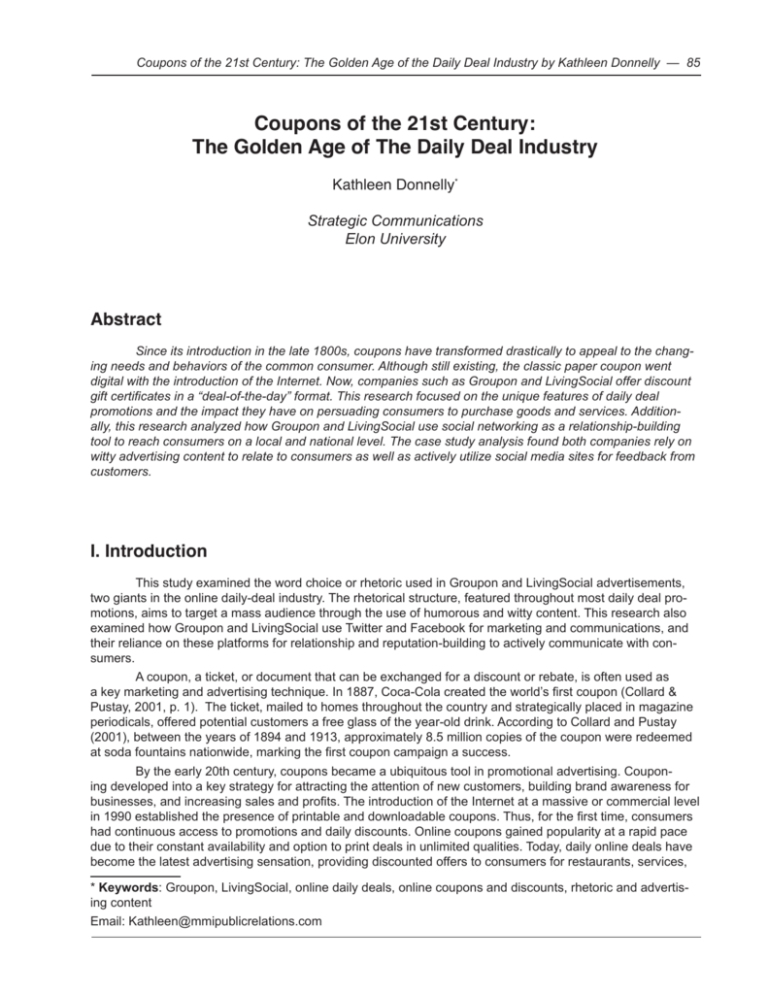
Coupons of the 21st Century: The Golden Age of the Daily Deal Industry by Kathleen Donnelly — 85 Coupons of the 21st Century: The Golden Age of The Daily Deal Industry Kathleen Donnelly* Strategic Communications Elon University Abstract Since its introduction in the late 1800s, coupons have transformed drastically to appeal to the changing needs and behaviors of the common consumer. Although still existing, the classic paper coupon went digital with the introduction of the Internet. Now, companies such as Groupon and LivingSocial offer discount gift certificates in a “deal-of-the-day” format. This research focused on the unique features of daily deal promotions and the impact they have on persuading consumers to purchase goods and services. Additionally, this research analyzed how Groupon and LivingSocial use social networking as a relationship-building tool to reach consumers on a local and national level. The case study analysis found both companies rely on witty advertising content to relate to consumers as well as actively utilize social media sites for feedback from customers. I. Introduction This study examined the word choice or rhetoric used in Groupon and LivingSocial advertisements, two giants in the online daily-deal industry. The rhetorical structure, featured throughout most daily deal promotions, aims to target a mass audience through the use of humorous and witty content. This research also examined how Groupon and LivingSocial use Twitter and Facebook for marketing and communications, and their reliance on these platforms for relationship and reputation-building to actively communicate with consumers. A coupon, a ticket, or document that can be exchanged for a discount or rebate, is often used as a key marketing and advertising technique. In 1887, Coca-Cola created the world’s first coupon (Collard & Pustay, 2001, p. 1). The ticket, mailed to homes throughout the country and strategically placed in magazine periodicals, offered potential customers a free glass of the year-old drink. According to Collard and Pustay (2001), between the years of 1894 and 1913, approximately 8.5 million copies of the coupon were redeemed at soda fountains nationwide, marking the first coupon campaign a success. By the early 20th century, coupons became a ubiquitous tool in promotional advertising. Couponing developed into a key strategy for attracting the attention of new customers, building brand awareness for businesses, and increasing sales and profits. The introduction of the Internet at a massive or commercial level in 1990 established the presence of printable and downloadable coupons. Thus, for the first time, consumers had continuous access to promotions and daily discounts. Online coupons gained popularity at a rapid pace due to their constant availability and option to print deals in unlimited qualities. Today, daily online deals have become the latest advertising sensation, providing discounted offers to consumers for restaurants, services, * Keywords: Groupon, LivingSocial, online daily deals, online coupons and discounts, rhetoric and advertising content Email: Kathleen@mmipublicrelations.com 86 — The Elon Journal of Undergraduate Research in Communications • Vol. 3, No. 2 • Fall 2012 ticketed events, goods, and other items (Byers, Mitzenmarcher, & Zervas, 2010). The majority of online coupons offer a discount or reduction in cost, a percentage discount, or free shipping (Collard & Pustay, 2001). Groupon and LivingSocial, founded respectively in 2008 and 2009, feature discounted gift certificates and coupons to local or national companies. In order to reach consumers, these sites use special marketing techniques intended to match the needs of their target markets. Additionally, both companies rely on the benefits provided by social media sites such as Facebook and Twitter to actively reach consumers on both a local and national level. Groupon and LivingSocial utilize social media sites as a public forum, posting the daily discounts and promotions, and as a relationship-building tool to maintain communication with consumers (Arasbshahi, 2010). Groupon, headquartered in Chicago, serves over 500 markets and 44 countries. The company was launched in 2008 by Andrew Mason and now has over 10,000 employees located throughout the world. According to its website, “We want each Groupon purchase to feel too good to be true, from the moment you buy the deal to the day you use it” (Groupon, 2012, p. 1). A unique feature to the company is its tailored “Groupon Now” service as well as its Groupon VIP program. Groupon Now is a smartphone and tablet-friendly application that allows users to push an “I’m hungry” or “I’m bored” button to view the best and closest deals for food and entertainment. The Groupon VIP program, launched in February 2012, offers members access to deals 12 hours earlier than non-VIP members at a fee of $30 a month (Groupon, 2012, p. 1). Living Social, based in Washington, D.C., operates in over 600 markets across six continents. The company has more than 60 million members worldwide and the numbers of vouchers purchased since the company was founded in 2009 total 63 million. (LivingSocial, 2012, p. 1) The company specializes in daily deals for escape and travel packages, family friendly activities, adventures, takeout and delivery, and gourmet dining. According to its website, “We help great local businesses grow by introducing them to high-quality new customers, and give merchants the tools to make our members their regulars” (LivingSocial, p. 1). II. Literature Review In the following literature review, the author reviewed scholarly articles on theoretical framework behind Groupon and LivingSocial, audience perception and attitudes toward them, and use of rhetoric and social media in daily deal promotions. Theoretical Framework Persuasion, with roots dating back to the ancient Greeks and Aristotle, is a key concept in modernday advertising. Much of Aristotle’s early research recognized that one specific approach to persuasion did not generally fit all situations. Instead, a persuasive speaker must adapt based on the context of the message and its intended audience (Larson, 2010, p. 20). Although advertising and mass media were not yet invented, Aristotle recognized the idea of segmented audiences and the value of customizing the message to a target market. Both Groupon and LivingSocial have been recognized for their reliance on persuading consumers through targeted language and rhetoric. Aristotle’s Rhetoric, considered by many as the founding work on persuasion, focused on artistic proofs or appeals that persuaders use to create, manipulate or inspire action (Larson, 2010p. 20). Furthermore, effective persuasion consists of both artistic and inartistic proofs. Larson states, “The persuader controls artistic proof, such as the choice of evidence, the organization of the persuasion, style of delivery, and language choices” (Larson, 2010, p. 20). On the other hand, inartistic proofs include instances that cannot be controlled by the speaker. Aristotle believed that persuasion can be judged as successful or unsuccessful based on three forms of artistic and inartistic proofs: ethos, pathos and logos. These aspects of communication appear in almost all forms of persuasion as an attempt to appeal to an audience. Ethos refers to the ethical appeal or sense of the author’s credibility while pathos, or emotional appeal, means to persuade a receiver by appealing to their emotions (Killingsworth, 2005, p. 251). Pathos is commonly associated with ‘colorful’ language and imagery used by the persuader to spark strong emotion and feelings. Larson notes that pathos can be developed through the use of meaningful language, emotional tone, emotion evoking examples, stories of emotional events, or implied meanings (Larson, 2001, p. 21). Logos, the final criteria for judging a persuasive message, Coupons of the 21st Century: The Golden Age of the Daily Deal Industry by Kathleen Donnelly — 87 is the appeal to logic or reasoning. For example, many forms of persuasion, including advertising, cites specific facts and statistics to appeal to a receiver. Successful persuasion must use a combination of these three tactics to relate to an audience. Audience Perception and Attitudes Although the majority of the research finds a strong customer relationship between daily deal websites and their subscribers, room for growth remains. Groupon and LivingSocial have positioned themselves successfully within their subscribers and the businesses they promote. Streitfeld (2010) explains, “The hope instead is that users will eventually perceive it as an impartial guide to a city or a neighborhood, somewhat in the manner of the local paper’s weekend section” (p. 2). This research highlights the successful tactics and appeals utilized by the most popular daily deal companies. Consumer perceptions and attitudes specifically regarding Groupon and its competitor, LivingSocial, will be discussed in greater detail in the findings section. Rhetoric and Daily Deal Promotions Aristotle’s findings on persuasive communication set the groundwork for the advertising and marketing industry. Successful advertisers must appeal to their audiences through the three persuasive proofs as outlined by Aristotle. (Killingsworth, 2005). Therefore, many companies, such as Groupon and LivingSocial use certain types of language and rhetoric to play on the emotions of the audience. In other words, daily deal sites focus heavily on word usage and rhetoric to establish a strong relationship with potential customers. By building and maintaining this relationship, daily deal websites will continue to build a healthy reputation among its target markets. LivingSocial and Groupon offer a new deal each day to all members who subscribe via email. Both web services email subscribers at least two times a day to promote discounts on products and services offered by merchants at both a national and local level. In terms of local promotions, the deals depend on the geographic region chosen by each subscriber. Through the initial enrollment process, the subscriber indicates their zip code, gender and age. Then, the companies send consumers the most relevant deals based on the information provided through email messages, Twitter blasts, and Facebook posts. Both Groupon and LivingSocial employ a large number of copywriters to draft descriptions of each deal featured by email, website, and social media postings. The promotional text has been seen as a contributing factor to the success and popularity of the sites (Dholakia & Kimes, 2011). More specifically, copywriters rely on a unique mix of thorough fact-checking statistics and witty humor to relate to their target market. Daily Deal Promotions and Social Media Within the decade, companies have consistently utilized social media as a marketing and advertising tool. Social media sites such as Twitter, Facebook, LinkedIn, etc. constantly post promotions and daily discounts for companies, restaurants, trips and escapes, and so forth. (Streifeld, 2001). Businesses and corporations are beginning to view social media as channels to reach their key audiences and publics. Social media sites have transformed the way people operate their businesses by expanding at an exceedingly rapid rate (Ye, Wang, Aperjis, Huberman & Sandholm, 2011). Many individuals rely on social networking sites, for example, to assess peer reviews on products and services. For businesses, social media allows them to communicate with dissatisfied consumers, build brand awareness, and actively advertise their product or service. Erik Qualman (2011) outlines specific tools and tactics often used to engage the attention of consumers via social media marketing. These tactics include communicating with dissatisfied customers on their own social networks, creating brand profiles on popular social networks, and creatively advertising within social media through the creation of brand-related applications, promotions, and podcasts. (Qualman, 2011). Research Questions This research sought to answer the following three questions: Q1: How do Groupon and LivingSocial connect with consumers through their use of strategic word choice, language, content and humor? Q2: What are the common characteristics, demographic information, and needs and wants of the typi- 88 — The Elon Journal of Undergraduate Research in Communications • Vol. 3, No. 2 • Fall 2012 cal Groupon user versus the typical LivingSocial user? Q3: How do Groupon and LivingSocial actively communicate with subscribers through social media sites? III. Methodology This study sought a clearer understanding of how Groupon and LivingSocial connect with consumers through advertising content and social media usage. Additionally, the research discussed common characteristics among typical daily deal users. To achieve the desired results, the researcher conducted a case study analysis of the two daily deal companies, Groupon and LivingSocial. The case study is a qualitative analysis of the two companies based on prior quantitative research conducted on each company’s consumer demographics, levels of awareness and usage and subscriber base. According to Yin (1984), “Case study research excels at bringing us to an understanding of a complex issue or object and can extend experience or add strength to what is already known through previous research” (p. 23). Case studies provide a systematic method for effectively collecting data, analyzing information, and reporting and responding to the results. The second part of the study examined how Groupon and LivingSocial are using social networking sites through a qualitative content analysis of each company’s Facebook and Twitter page. Two consecutive weeks were chosen at random, and were used to collect content from both company’s national Twitter and Facebook accounts. The weeks chosen by the researcher for content analysis were March 1 (12:00 a.m.) to March 15 (11:59 p.m.). Posts were analyzed based on dialogue and feedback from consumers. This case study focused on the ways in which each company communicates with subscribers through social media as well as the consideration of rhetoric and word choice when advertising deal promotions. The researcher looked to gain detailed insight into the characteristics of both companies, tactics used to communicate with their customers on social media sites, and the importance of rhetoric and reliance on humor to communicate with their target markets. IV. Findings Groupon Case Study Groupon’s heavy subscriber base—surpassing 50 million according to recent news reports (Streitfeld, 2011) —is essentially an email distribution list segmented by geographical boundaries. Email is a cheap and successful mechanism to reach subscribers in an easy and timely fashion. Email and social media sites allow Groupon to target the maximum relevant geographic area when promoting a local merchant. Utpal M. Dholaki and Kimes (2011) examined the insights of a diverse sample of 973 respondents. Their results show that consumers are more willing to buy deals that appeal to them through creative images and languages. Also, it indicates that despite previous worries and anxieties, there is no evidence of daily deal fatigue. Their survey-based study found that the ‘heaviest’ daily deal users were the most enthusiastic about daily deal sites. This indicates that Groupon established itself as a credible business and has formed strong relationships between customers and the company. They [heavy users] indicate the greatest interest in checking their email for deal offers everyday, have little trouble in using the deals before they expire, believe that daily deals help them save money on things they would have purchased anyway, and say they have integrated these deals into their usual shopping behavior. (Dholakia & Kimes, 2011, p. 1) In terms of demographic information, Dholakia and Kimes’ research indicates that the majority of Groupon subscribers lived in urban areas. Additionally, most of the users were female (p. 5). Although promotions can appeal to both men and women, Groupon often speaks to women by focusing promotions on the health, fitness and beauty markets. Finally, Dholakia and Kimes’ (2011) analyzed subscribers’ awareness, usage, and perception of various daily deal websites. According to their results (2011), awareness levels for Groupon were the high- Coupons of the 21st Century: The Golden Age of the Daily Deal Industry by Kathleen Donnelly — 89 est with 93.6%, followed by Restaurant.com (83.1&), and LivingSocial (80.2%) (p. 16). Similarly, Groupon had the largest proportion of users (56.6%), followed by Restaurant.com (46.1%), and LivingSocial (45.8%). The participants in this study were asked which of the daily deal sites was their favorite, the website with the largest “heart share.” The results showed Groupon had the highest heart share with 43.3% of the respondents indicating Groupon as their favorite daily deal site. Following Groupon, Restaurant.com has16.2% heart share and LivingSocial has only 7.3%. The conclusion of the research showed: Where the two major daily deal sites are concerned, these numbers are positive from the standpoint of Groupon, indicating its relative brand strength, and may be a cause of concern for LivingSocial given the relatively few daily deal users who consider it as their favorite site. (Dholakia & Kimes, 2011, p. 17) Thus, these results indicate Groupon as the daily deal company with the highest brand awareness, most subscribers, and highest heart share. Arabshahi performed an analysis on Groupon’s business model in December of 2010. According to his research (2010), “Each deal region—usually a densely populated urban best described as an ‘expanded local’—is large enough to cover any subscriber with the potential to participate” (p. 1). His research asserts that Groupon and LivingSocial are mediated platforms that connect people seeking bargains with merchants willing to provide them. He believes the harvesting of the maximum geographic area maximizes Groupon’s ability to generate customers for local merchants. Additionally, Arabshahi noted that an integral part of every Groupon deal is the actually message embedded in the deal email, tweet, or Facebook post. The creative and humorous messages, prepared by Groupon’s expert writers, aims to highlight the attributes of the offered product or service. Many attribute their use of unique language to generate emotion as one of their key tactics for success. For example, a recent article from The New York Times, asserts, “Groupon’s breakthrough sprang not just from the deals offered but also from an ingredient that was both unlikely and ephemeral: words” (Streitfeld, 2011, p. 1). Borrowing tools and terms from journalism, Groupon softened the traditional heavy content of advertising and added banter, attitude, playfulness, emotion and humor to relate to their subscribers on a lighter level. The primary goal of their messages is to spark excitement for the deal and coax subscribers into purchasing the offered deal. Groupon’s brand of subtle humor is often referred to as the “Groupon Voice” (Streitfeld, 2011). For example, currently, Groupon is offering a deal with Cary Yoga and Kickboxing in Cary, N.C. This deal is available to all subscribers but is sent specifically to subscribers that live in the Cary, Durham, Raleigh or greater Triangle region. The message on this advertisement is a clear example of how Groupon’s uniquely written copy. Perspiration gets mischievous when cooped up inside the body, acting out by drenching armpits on first dates and disguising itself as tears during job interviews. Release disgruntled body water with this Groupon to Cary Yoga and Kickboxing. (Groupon, 2012, p. 1) This artistically scripted message proves Groupon relies on poetic and humorous word choice as an attempt to appeal to subscribers and to persuade them to purchase their promotional deals. Some of the company’s rules for their written content is that the passive voice must be avoided at all times and pop culture references are verboten. According to The New York Times, (2011), “A write-up for a teeth-whitening service said it was equivalent to being punched by God twice. Angry letters followed” (p. 3). Groupon’s “comedy writers,” as they are referred to throughout the company, sit together and often share office space at the company’s headquarters in Chicago. Dholakia and Kimes (2011) also focused on the typical behaviors of Groupon subscribers and their reliance on social media sites. The study indicates that heavy deal users, those who have purchased more than 11 daily deals, are interested in checking their email, Facebook, or Twitter account for Groupon’s daily deal promotions. All three-user groups, novice users, users and heavy users, indicated they actively check social media sites for daily deal updates. However, the study found most users rely more heavily on automatic email subscriptions to purchase daily deals rather than Facebook and Twitter. Additionally, the researchers noted, “It appears that the ‘social’ aspect of daily deals is not as important to our sample respondents as is the personal aspect of looking for and receiving a good deal” (Dholakia & Kimes, 2011, p. 7). Heavy daily-deal users indicated email as their main means of communication with Groupon. The respondents in the survey were not as enthusiastic as sharing promotions through social networking sites like Facebook and Twitter. The results indicated that Groupon subscribers are more likely to purchase deals when received via email notifications. In 90 — The Elon Journal of Undergraduate Research in Communications • Vol. 3, No. 2 • Fall 2012 terms of additional social media promotions, Groupon offered $10 in “Groupon Bucks” whenever a consumer referred a friend to Groupon through email links, Facebook or Twitter. With a heavy subscriber base of over 50 million, Groupon uses social media tools such as Twitter and Facebook to engage in conversations with consumers, advertise promotions to followers, and keep up on the latest trends of the industry. Currently, Groupon has 445,313 likes on their international Facebook page, 57,723 followers on their Twitter page, 480,000 monthly users on the international Groupon application (Patel, 2011). As an example of a local site, the Groupon Facebook page for Raleigh/Durham has 3,309 likes. Although these numbers are high, the potential for continued growth is evident based on their market of more than 50 million subscribers. The engagement on both social media sites, however, is very interactive. Twitter tends to be more interactive in terms of consumer relations as they give specific replies to most, if not all, tweets from customers. Facebook, used more as a tool to advertise and post daily deals, interacts with fans as well, however, not as often or as heavily as with followers on Twitter. Posts on Facebook are often done on a daily basis while Twitter posts tend to be on an hourly or more frequent basis. However, on Facebook, there is constant access to the Groupon application, which allows individuals to download, view, and purchase daily promotions from their Smartphone. Groupon’s reliance on social media is highly compared to many other international companies; however, there is clear room for improvement in the future. The Groupon case study indicates that consumers use social media sites to learn about daily deal; however, they mostly rely on automatic daily emails for purchasing their deals. The majority of subscribers use Facebook and Twitter solely as a means of communication with the company. Many customers tweet their feedback to the national Groupon Twitter as well as the Groupon Twitter of their city or region. With social properties in over 500 cities around the world, Groupon actively maintains Facebook and Twitter accounts for nearly all of their market cities. Groupon uses Facebook and Twitter to post deals, initiate conversation with consumers, and post relevant information, tips, or pointers. Their reliance on Twitter and Facebook helps the company build and maintain close customer relations and strong brand awareness. Additionally, the case study proved that content in all advertisements and promotions is crucial to the success of the company. Creative and humorous messages are created for each deal to sway and persuade subscribers to purchase the promotions. Groupon hires expert and experienced writers to use unique language to appeal to the emotions of each subscriber. This persuasion tactic and technique speaks directly to Aristotle’s belief of the power of appeal to ethos, logos, and pathos in successful communication. Finally, the case study indicated that the ‘heaviest’ or most active daily-deal users were the most enthusiastic about daily deal sites. LivingSocial Case Study Neither Groupon nor LivingSocial require any up-front money investment or subscription fee. However, the majority of Groupon and LivingSocial users are in search of a bargain or daily promotion. Like Groupon, a subscriber is able to access LivingSocial through an email address, Facebook login, Twitter application or mobile device. LivingSocial offers several daily deals in a wide array of categories to accommodate many different users. After analyzing the user demographics, advertising content, and social media usage of Groupon subscribers, this case study examines the users of LivingSocial and highlights their common characteristics, persuasion tactics and reliance on language, and social media practices. A Nielsen Co. survey, conducted in April 2011, claims that individuals purchasing coupons from LivingSocial tended to be more successful, younger and smarter than Groupon customers (Flinn, 2011). The results indicate LivingSocial users are 49% more likely than the average American to make at least $150,000 annually, compared with 30% for Groupon. Furthermore, LivingSocial users are more likely to have college graduate degrees and be younger than 35 years old. Approximately one third of LivingSocial buyers are in the 21-to-34-age range. Also, the study claimed 46 percent of LivingSocial users had attended or previously graduated from college, compared with 39 percent for Groupon (Flinn, 2011). Although these numbers are pretty similar, it is very interesting to note that LivingSocial users tend to be more profitable, educated, and younger compared to Groupon subscribers. Furthermore, based on demographic-driven research, LivingSocial is stronger in the Eastern region of the United States, while Groupon tends to be more successful in the Midwest and Pacific regions (Flinn, 2011). Although LivingSocial is not directly known for its use of humor in its advertising content, as Groupon is, the company does rely on subtle humor and emotional language to appeal to consumers. For example, the opening line explaining a deal offering ten jazzercise classes at a Chapel Hill gym read, “Obsessively checking Facebook to untag unflattering pics posted by your friends is hardly the right was to procrastinate. Swap Coupons of the 21st Century: The Golden Age of the Daily Deal Industry by Kathleen Donnelly — 91 sweating the small stuff for sweating the pounds off at Jazzercise Fitness Center of Chapel Hill” (LivingSocial, 2012, p. 1). The description of this deal is a strong example of the light and airy language LivingSocial writers use to reach consumers on a friendly and comfortable level. The advertisement used words such as ‘untag’ and ‘pics’ as an attempt to communicate with the consumer on a relatable level. Similar to Groupon, the description for each daily deal is carefully and artistically scripted to appeal to the emotions of each subscriber. LivingSocial is relatively active on social media sites such as Facebook and Twitter. Currently, the LivingSocial Facebook page has 1,278,076 likes (compared to Groupon’s 445,313), has 2,300,000 monthly users for the LivingSocial application (Groupon’s is 480,000), and 132,355 followers on Twitter (compared to Groupon’s 57,723 followers). Obviously these numbers prove LivingSocial, as an international company, has a much larger base of followers and fans on social media. However, this analysis does not account for the fact that Groupon has additional Facebook and Twitter accounts for nearly all of the participating cities. Therefore, many subscribers may solely follow or “like” the account for their particular geographic region for Groupon. LivingSocial, on the other hand, only has a handful of Twitter and Facebook accounts for participating cities. Instead, they rely more on building awareness at the international brand level. LivingSocial utilizes social media sites in a unique fashion. According to its website, a consumer has the option of sharing their purchased deal via email, Twitter or Facebook to friends, family members and followers. If three people buy the deal through the link, the deal is free to the original purchaser. This exclusive tactic encourages consumers to spread the word about specific deals and promotions. It also has the potential to raise brand awareness and positive association with the company if the consumer receives a free deal. As the second highest grossing and most successful daily deal site in the world (behind Groupon), LivingSocial CEO, Tim O’Shaughnessy must attempt to keep pace with the company’s largest competition and must work to plot his own course for setting his company apart. A key aspect in O’Shaughnessy’s plan is to start moving beyond promotions for mom-and-pop businesses. For example, in September 2011, LivingSocial offered $20 worth of goods at Whole Foods for $10. According to MacMillan (2011) from Bloomsberg Businessweek, approximately 80 people bought the deal per every one-second, marking it the company’s fastest-selling coupon. Approximately 100,000 new subscribers joined LivingSocial to get access to this specific deal. Similarly, in January 2011, LivingSocial offered $20 Amazon gift card for $10, resulting in a sale of over 1.4 million vouchers and an incredible amount of media attention. Although offering national deals means LivingSocial paying more than usual out of pocket, subscribers are more likely to purchase deals offered at a national level (MacMillian, 2011). According to another research conducted by Steiner (2010) in an article published in Forbes magazine, “Chief Executive Timothy O’Shaughnessy thought LivingSocial has a long-term edge on Groupon and other competitors because it puts a handful of full-time salesperson in each of the cities the company has relationships and active promotions with” (p. 2). Furthermore, a key study regarding group deals (2011) found deals in LivingSocial tended to grow faster than Groupon in the first few hours the deals are offered. The research claimed that a possible reason for this is due to the different incentives LivingSocial uses to promote each deal (Ye, Wang, Aperjis, Huberman & Sandholm, 2011). The case study conducted on LivingSocial indicates continued growth for both the company and the online coupon market. Although still working to catch up with the overwhelming success of its number one competitor, Groupon, LivingSocial is constantly increasing merchant base, brand awareness, loyalty among subscribers, unique advertising content, and reliance on social media sites. Over one million LivingSocial subscribers have purchased three or more deals. Customers, therefore, are relatively happy with the results. V. Conclusion Coupon purchasing is at an all-time high. The 2012 Coupon Fact Report, issued by NCH Marketing Services, reported $470 billion of coupon value was offered by marketers to consumers in 2011 (NCH, 2012). Shoppers responded to the report by redeeming $4.6 billion in savings, an increase of 12.2% over the year prior, and 58.6% higher than five years ago (NCH, 2012). Coupons have adapted to the 21st century shopper by appealing to the masses on the Internet. Online coupon sites, such as Groupon and LivingSocial, are the new couponing system offering daily deals to subscribers through email, Facebook and Twitter. The case study analysis indicates the heaviest daily deal users are the most enthusiastic about 92 — The Elon Journal of Undergraduate Research in Communications • Vol. 3, No. 2 • Fall 2012 receiving daily deal alerts and notifications. Despite worries from the online coupon industry, users did not indicate a fatigue of daily deals. On the contrary, the market is continuing to grow and businesses continue to be interested in working with daily deal websites to increase their revenues. The majority of users of both Groupon and LivingSocial are interested in purchasing a deal in the near future. In terms of demographic information, most subscribers of Groupon and LivingSocial were women and lived in urban cities. The case study indicated LivingSocial subscribers as more successful and younger than the typical Groupon user. Additionally, LivingSocial users tend to live in the Eastern regions of the United States, while Groupon users live in the Midwest and Pacific regions of the country. When comparing the two companies, Groupon has the higher percentage of awareness among consumers. They also have the higher number of subscribers, although the number of LivingSocial subscribers is growing at a faster rate. Users indicated Groupon as their favorite daily deal website, followed by Restaurant. com and LivingSocial in third. Although research found Groupon as the most popular daily deal company, the market for both sites continues to expand. According to Patal (2011), Even though Groupon has undoubtedly fallen from the grace of the press in recent months after drawing back its financial curtain for an initial public hearing, the fact remains: U.S. consumers are still gaga for deals and Groupon is their favorite site by far, with few reporting any shade of deal fatigue. (p. 79) Both Groupon and LivingSocial relate to subscribers through emotion-provoking language and word choice in each daily deal description. Both companies rely on the message embedded in the email, tweet, or Facebook post to effectively persuade subscribers to purchase the promotion. Groupon, in particular, uses creative, humorous and witty content to relate to subscribers on a friendly and lighter level. Each company scripts artistic content through poetic and humorous word choice to entice subscribers to purchase deals. This advertising technique directly relates to Aristotle’s early research on appeal to the audience in terms of the three forms of artistic and inartistic proofs: ethos, pathos and logos. These aspects of communication appear in almost all forms of Groupon’s and LivingSocial’s advertising content to relate to an individual receiver. The case study analysis found that Groupon and LivingSocial rely on social media sites to increase their subscriber base, intensify brand awareness, advertise daily deal promotions and communicate with consumers at a friendly and comfortable level. Although the heaviest of daily deal users indicated email as their main means of communication with the two companies, respondents remained enthusiastic about sharing promotions with friends and followers through social networking sites. Interestingly, LivingSocial has more Facebook fans and Twitter followers; however, Groupon offers subscribers the chance to follow Facebook and Twitter sites for all cities involved in the promotions. LivingSocial, on the other hand, focuses more on the company’s general and international Twitter and Facebook accounts. Both companies tend to rely more on Twitter rather than Facebook to interact with customers. Groupon, LivingSocial and other companies in the daily deal industry have potential for growth and expansion. If daily deal websites continue to relate to its audience on a national and local level, communicate with subscribers through humorous and witty messages, rely on social media sites to provide open and honest feedback with users, they will continue to see success in the coming future. The business model used by both companies will be sustainable as long as they continue to offer value to both subscribers and businesses involved in the daily promotions. According to Arabshahi (2010), “Almost 88.2 million people, half of all U.S. adult Internet users, will redeem an online coupon in 2011, and this number should increase to 96.8 million by 2013” (p. 6). At the end of the day, consumers are always going to search for the best deal, thus, fueling the long-term growth and sustainability of the daily deal industry. Acknowledgments The author would like to extend a thank you to Dr. Victor Costello at Elon University for all of his guidance, inspiration and support throughout the process of researching and writing this article. The author is also thankful to Doctor Byung Lee, associate professor of Elon University’s School of Communications, for his supervision and help of revision for this article. This research would not have been possible without their support and dedication. Coupons of the 21st Century: The Golden Age of the Daily Deal Industry by Kathleen Donnelly — 93 Bibliography Arabshahi, A. (2010). An analysis of the Groupon business model. Undressing Groupon, 1-16. Retrieved from http://www.ahmadalia.com/download/Undressing-Groupon.pdf. Byers, J. W., M. Mitzenmarcher & Zervas, G. (2012). Daily deals: Prediction, social, diffusion, and reputational ramifications. WSDM ’12: Proceedings of the Fifth ACM International Conference on Web Search and Data Mining. New York: ACM. Collard, C., Pustay, M., Roquily, C. & Zardkoohi, A. (2001). Competitive cross-couponing: comparison of French and U.S. perspectives. Journal of Public Policy & Marketing, 20(1), 64-72. Retrieved from http://www.jstor.org/stable/30000645 Dholakia, U. M. & Kimes, S. E. (2011). Daily deal fatigue or unabated enthusiasm? A study of consumer perceptions of daily deal promotions. Social Science Research Network. Retrieved from http://ssrn.com/ abstract=1925865 Flinn, R. (2011). LivingSocial buyers richer, smarter than Groupon’s, study says. Bloomsbery Businessweek. Retrieved from http://www.businessweek.com/news/2011-0427/livingsocial-buyers-richer-smarterthan-groupon-s-study-says.html. Groupon. (2012). How it works. Groupon. Retrieved from http://www.groupon.com/learn. Killingsworth, J. M. (2005) Rhetorical appeals: A revision. Rhetorical Review, 24(3). 249-263. Retrieved from http://www.jstor.org/stable/20176660 Larson, C. U. (2010). Persuasion: Reception and Responsibility. Boston: Wadsworth Cengage Learning. LivingSocial. (2012). Discover the best deals in your city. Retrieved from http://livingsocial.com/deals/how_it_ works. MacMillan, D. (2011). LivingSocial aims to be different from Groupon. Bloomsberg Businessweek. Retrieved from http://www.businessweek.com/magazine/livingsocialaims-to-bedifferent-from-groupon-09222011. html NHC Resource Center. (2012). The 2012 NHC coupon facts report. Retrieved from https://www.nchmarketing. com/ResourceCenter/ Patel, Kunur. “Think Consumers Are Tired of Deals? Better Think Again.” Advertising Age, 82(33), 78-79. Communication and Mass Media Complete; EBSCOhost. Retrieved on February 22, 2012 from http:// ebscohost.com/ehost/delivery?sid=d6bbd7661a15-46dd-88bd-abc11 Qualman, Erik. (2011). Socialnomics: How social media transforms the way we live and do business. Business Book Summaries. Ipswich, MA: EBSCO Publishing Inc. Retrieved from http://www.ebscohost. com/uploads/corpLearn/pdf/bbs_socialnomics.pdf. Steiner, C. (2010). Meet the fastest growing company ever. Forbes. August 30, 2010. Retrieved from http:// www.forbes.com/forbes/2010/0830/entrepreneurs-groupon-facebook-twitternext-web-phenom_3.html. Streitfeld, D. (2011). Funny or die: Groupon’s fate hinges on words. The New York Times. Retrieved from http://www.nytimes.com/2011/05/29/business/29groupon.html?_r=1&pagewanted=all. Ye, M., Wang, C. Aperjis C., Huberman, B. A. & Sandholm, T. (2011). “Collective attention and the dynamics of group deals.” Cornell University Library. Retrieved from http://arxiv.org/abs/1107.4588. Yin, R. K. (1984). Case study research: Design and methods. Newbury Park, CA: Sage.
